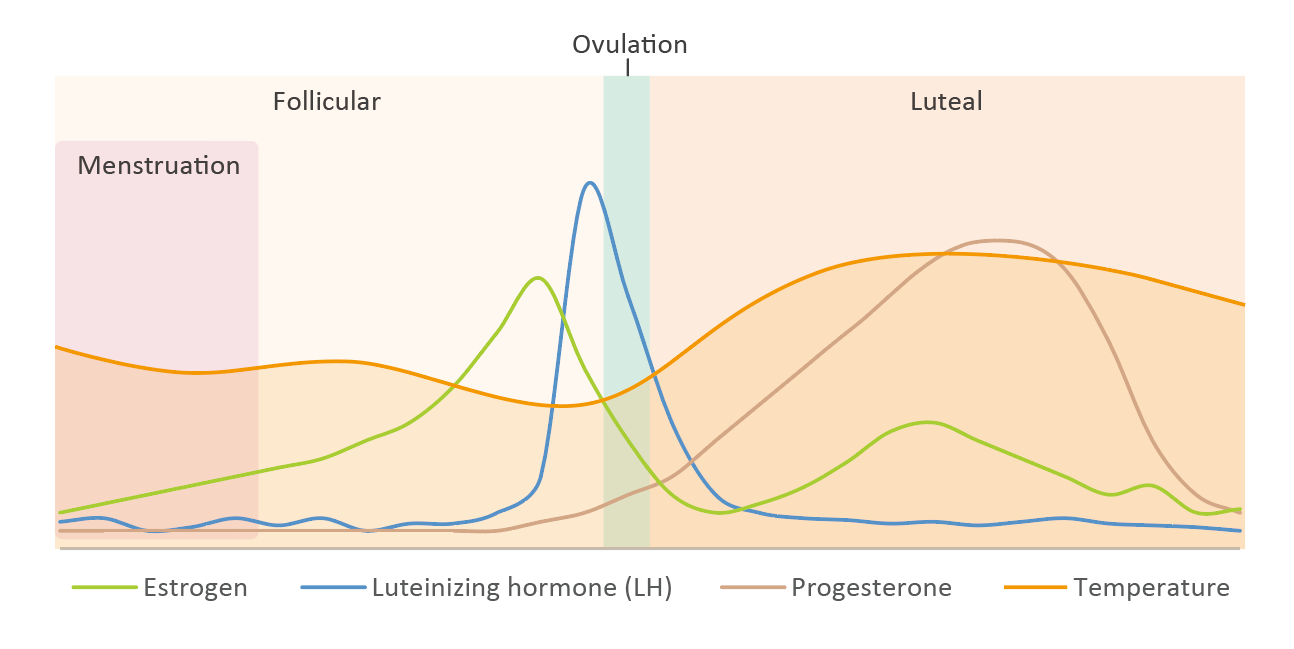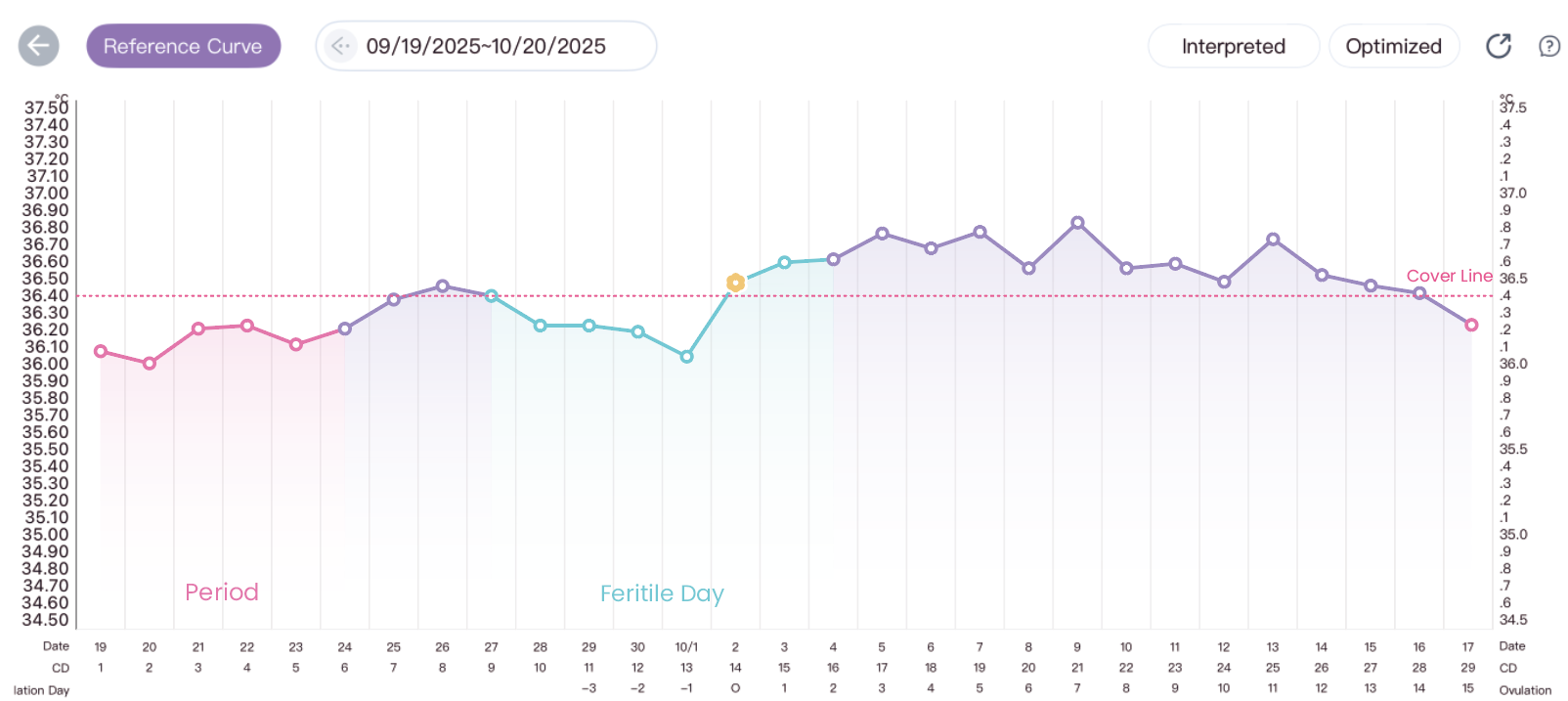From a scientific perspective, the Femometer Ring uses the basal body temperature method to track the menstrual cycle, which is regulated by subtle physiological shifts, primarily hormonal fluctuations that affect body temperature. Tracking these temperature changes can help identify different menstrual phases, estimate ovulation, and detect irregularities.
Why does body temperature change throughout the cycle?
Hormonal changes across the menstrual cycle influence the body’s thermoregulation:
- During menstruation and the follicular phase, estrogen is dominant, and body temperature typically stays at a lower baseline.
- After ovulation, estrogen levels decrease while progesterone rises, causing a measurable increase in basal body temperature, usually about 0.3–0.7°C (0.5–1.3°F) starting the day after ovulation.
- During the luteal phase, progesterone remains elevated, so temperature stays higher until just before the next period, when progesterone drops and temperature returns to baseline.

But this pattern can vary significantly from person to person:
- The length of each phase (follicular and luteal) can differ from person to person, or even month to month.
- Some cycles are anovulatory (no ovulation), which is common during stress, illness, or hormonal imbalance.
- People with PCOS may have irregular or unpredictable ovulation timing. This is why a tracking method must adapt to the individual user’s physiology rather than rely on fixed assumptions.
Finger Temperature vs. Oral Temperature
Users often wonder: Can finger temperature really replace oral BBT? For menstrual cycle tracking purposes, the answer is yes! When measured during a restful state, both oral and finger temperature follow the same cyclical patterns. Oral BBT taken first thing in the morning is usually stable and close to core body temperature, but it is not ideal for long-term or continuous monitoring, and it can be affected by sleep quality, mood, getting out of bed late, and even the length of time asleep. Finger temperature fluctuates more throughout the day, but it is ideal for continuous passive tracking. The Femometer Ring is worn during sleep, when finger temperature naturally stabilizes. Although finger temperature is more reactive to ambient conditions, the fingertips are the body’s primary points of heat dissipation, so the fingers provide rich data about thermoregulation.
Why measure at the finger?
Femometer chose the inside of the finger for three key reasons:
- Comfort & compliance – A ring is easy to wear and doesn’t interfere with sleep.
- Sensitivity – The skin on the fingers is highly responsive to blood flow changes, making it easier to detect subtle shifts.
- High-accuracy sensing – Each Femometer Ring is equipped with three high-precision NTC temperature sensors. Every device is factory-calibrated so it reports absolute temperature values, not just relative changes.
Sampling & Algorithm
The Femometer Ring collects finger temperature once every minute during sleep. The algorithm identifies stable nighttime segments, filters out noise (such as hand movement or temperature interference), and extracts the higher values from those segments—since they are closer to core body temperature. In the Femometer App, users can view absolute temperature readings (e.g., 36.75°C). These are easier to understand than just a deviation value (e.g., +0.2°C), and they can also reflect other health conditions, for example, a nighttime temperature above 37.5°C may indicate fever or illness.
Temperature measurement accuracy
Before packaging, each Femometer Ring undergoes multiple rounds of temperature calibration using a precision-controlled water bath that maintains ±0.001°C accuracy across 10–40°C. Only rings with a measurement deviation within ±0.05°C are approved for shipping.
Ovulation prediction accuracy
In an internal Femometer study of 20 participants:
- Each participant wore the Femometer Ring for two full cycles to build a personalized model.
- From the 3rd to the 5th cycle, LH test strips were used for comparison.
- A total of 60 cycles were collected and analyzed.

- The chart shows the alignment between the ovulation day predicted by finger temperature taken from the Femometer ring and the ovulation day predicted by LH test strips. Almost half of the results are a perfect match, and most of the remaining cases fall within a range of -2 to +1 days showing that the Femometer Ring alone can accurately identify ovulation within a user’s first few months of use, achieving reliable results even within the first five cycles.
- Where we see '-2 days', this indicates that the ovulation day predicted by finger temperature was two days earlier than the ovulation day predicted by the LH strips. Because sperm can survive 3–5 days and the egg survives up to 24 hours after ovulation, this prediction window effectively covers nearly 100% of the fertile phase, even when ovulation is predicted two days earlier than it takes place.
Femometer’s Cycle Insights
The Femometer Ring builds a personal temperature model after it learns the user’s baseline and trends. During the first two cycles, predictions are based primarily on the calendar method, however ovulation confirmation takes place using the finger temperature data. After the first two cycles, once the personal model is established, each new cycle is predicted based on:
- The real-time temperature pattern of the current cycle, and
- The historical cycle model. Femometer provides a 7-day fertile window: 5 days before ovulation + the day of ovulation + 1 day after — aligned with sperm and egg viability.
 The app also predicts the start of the next period, though for accuracy, the user needs to confirm the start date manually.
The app also predicts the start of the next period, though for accuracy, the user needs to confirm the start date manually.
How to Improve Prediction Accuracy
To get the best results:
- Wear the ring every night during sleep and sync regularly with the Femometer App.
- Maintain a consistent sleep schedule with at least 4 hours of uninterrupted sleep.
- If you drink alcohol, become ill, or experience an abnormal spike in temperature, mark that night as “abnormal” in the temperature chart to help the algorithm avoid misinterpretation.
- Accurately log each period start date.
- Support your overall hormonal balance — chronic stress can disrupt temperature patterns by affecting the endocrine system.










